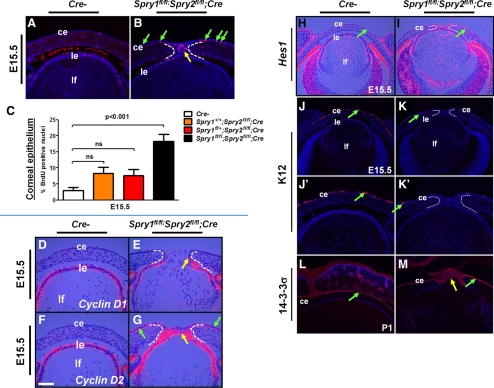Figure 9.
Cell proliferation and differentiation in Spry mutant corneal epithelial cells. (A–C) BrdU incorporation assay. Immunohistochemistry was performed on E15.5 Spry mutant (B) and control (A) embryos. BrdU proliferation index in the corneal epithelial cells (C) was quantified. Each genotype was compared to Cre− controls. Error bars, SEM. BrdU incorporation was significantly increased in the Spry mutant corneal epithelial cells (B, green arrows, C). (D–G) Cell cycle targets in the lens and cornea. In situ hybridizations were performed on E15.5 control (Cre−) and Spry mutant embryos to detect expression of cyclin D1 (D, E) and cyclin D2 (F, G). Cyclin D2 (G, green arrows) but not cyclin D1 (E) was upregulated in the Spry mutant corneas. Both cyclin D1 (E, arrow) and D2 (G, yellow arrow) were expressed in the stalk cells of Spry mutants. (H–M) Corneal epithelial differentiation. In situ hybridization (H, I) and immunohistochemistry (J–M) were performed on sections of control (Cre−) and Spry mutant embryos. In situ hybridization was performed with a 35S-labeled Hes1 riboprobe. (J′, K′) Higher magnifications of (J) and (K). Increased Hes1 expression in the Spry mutant corneal epithelial cells (I, green arrows) suggests an expansion of progenitor cells. Expression of K12, but not 14-3-3σ, a corneal epithelial differentiation marker, was reduced in Spry mutant corneas (K, K′, M). ce, corneal epithelium; le, lens epithelium; ir, iris; lf, lens fibers; r, retina. Scale bar in (F): (A, B, D–G, J′, K′) 20 μm; (H–M) 40 μm.

